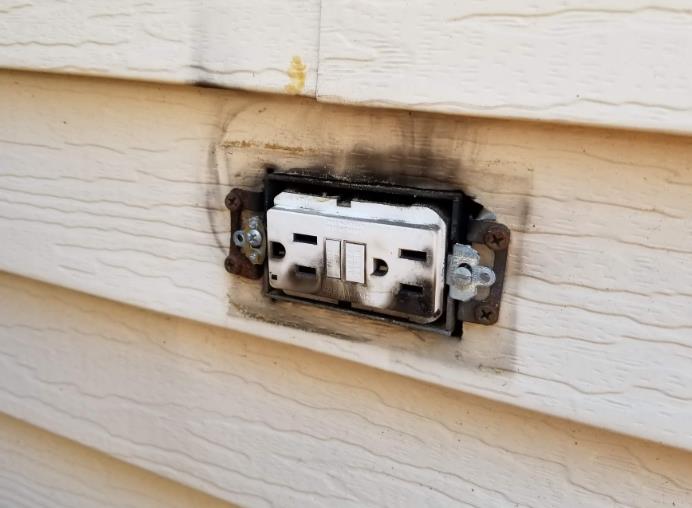The NEC (National Electrical Code) includes many specific requirements for installation of outdoor circuits and equipment. The primary safety focus on involves shielding against moisture and corrosion, preventing physical damage, and managing issues related to underground burial for outdoor wiring. With most residential outdoor wiring projects, the relevant code requirements include install outdoor receptacles and lighting fixtures, and run wiring above and below ground. The official code requirements that are with “listed” remarked means that the products used must be authorized for the application by an approved testing agency, such as UL (formerly Underwriters Laboratories).
For Outdoor Electrical Receptacles
Many of the rules applying to outdoor receptacle outlets are for purpose of reducing the likelihood of shock, which is a notable risk probably happens at any time a user is in direct contact with the earth. The principal rules for outdoor receptacles include:
- Ground Fault Circuit Interrupter protection is required for all outdoor receptacles. Specific exceptions may be made for snow-melting or deicing equipment, where the equipment is powered by an inaccessible outlet. The required GFCI protection can be provided by GFCI receptacles or GFCI circuit breakers.
- Homes must have one outdoor receptacle at least at the front and rear of the house for peace of mind. They must be readily accessible from the ground and positioned not more than 6 1/2 feet above grade (ground level).
- Attached balconies and decks with interior access (including a door to the indoors) must have a receptacle no more than 6 1/2 feet above the balcony or deck walking surface. As a general recommendation, houses also should have a receptacle at each side of a balcony or deck accessible from the ground.
- Receptacles in damp locations (under protective covers, such as a porch roof) must be weather resistant (WR) and have a weatherproof cover.
- Receptacles in wet locations (exposed to weather) must be weather-resistant and have a weatherproof “in-use” cover or housing. This cover usually provides sealed weather protection even when cords are plugged into the receptacle.
- A permanent swimming pool must have access to an electrical receptacle that is no closer than 6 feet and no further than 20 feet from the closest edge of the pool. The receptacle must be no higher than 6 1/2 feet above the pool deck. This receptacle must have GFCI protection as well.
- Receptacles used to power pump systems on pools and spas must be no closer than 10 feet from the inside walls of a permanent pool, spa, or hot tub if there is no GFCI protection offered, and no closer than 6 feet from the inside walls of a permanent pool or spa if they are GFCI protected. These receptacles must be single receptacles that serve no other devices or appliances.
For Outdoor Lighting
The rules apply for outdoor lighting are principally about using fixtures that are rated for use in damp or wet locations:
- Light fixtures in damp areas (protected by an overhanging eave or roof) must be listed for damp locations.
- Light fixtures in wet/exposed areas must be listed for use in wet locations.
- Surface-mounted electrical boxes for all electrical fixtures must be rain-tight or weatherproof.
- Exterior light fixtures do not require GFCI protection.
- Low-voltage lighting systems must be listed by an approved testing agency as an entire system or assembled from individual components that are listed.
- Low-voltage light fixtures (luminaires) must be no closer than 5 feet away from the outside walls of pools, spas, or hot tubs.
- Transformers for low-voltage lighting must be in accessible locations.
- Switches controlling pool or spa lights or pumps must be located at least 5 feet from the outside walls of the pool or spa unless they are separated from the pool or spa by a wall.
For Outdoor Cables and Conduits
Even though standard NM cable has a vinyl outer jacket and waterproof insulation around the individual conducting wires, it is not intended for use in outdoor locations. Instead, cables must be approved for outdoor use. And when using conduit, there are additional rules for following. The applicable rules for outdoor cables and conduits are as follow:
- Exposed or buried wiring/cable must be listed for its application. Type UF cable is the most commonly used nonmetallic cable for residential outdoor wiring runs.
- UF cable can be direct-buried (without conduit) with a minimum of 24 inches of earth cover.
- Wiring buried inside rigid metal (RMC) or intermediate metal (IMC) conduit must have at least 6 inches of earth cover; wiring in PVC conduit must have at least 18 inches of cover.
- Backfill surrounding conduit or cables must be smooth granular material without rocks.
- Low-voltage wiring (carrying no more than 30 volts) must be buried at least 6 inches deep.
- Buried wiring runs that transition from underground to above ground must be protected in conduit from the required cover depth or 18 inches (whichever is less) to its termination point above ground, or at least 8 feet above grade.
- Electrical service wires overhanging a pool, spa, or hot tub must be at least 22 1/2 feet above the surface of the water or surface of the diving platform.
- Data transmission cables or wires (telephone, internet, etc.) must be at least 10 feet above the surface of the water in pools, spas, and hot tubs.
Post time: Feb-21-2023


